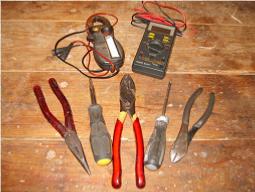Detect a Short in Electrical Wiring
With our new kitchen addition, which we will be posting soon, here are a few tips I learned on electrical work. Detecting a short in electrical wiring is a simple task once you understand what it means and how it was caused. An electrical short can be caused by two wires coming in contact with each other. Another cause maybe from a defective receptacle outlet or light fixture. An electrical short will show itself by fuses being repetitively blown or the circuit breaker tripping out constantly. By following the simple steps below should allow you to troubleshoot the problem.
One
Unplug the device, a toaster, microwave or lamp, that is connected to the circuit. Reset the breaker or replace the fuse. You want to eliminate any device that may be defective before proceeding. Energize the circuit, if the breaker or fuse does not blow, then the device is bad and should be repaired or replaced. If the circuit still trips out or blows the fuse then there is a possible short in the wiring or the receptacle.
Two
Switch off the circuit that keeps tripping or remove the fuse from the troubled circuit. Take the volt ohmmeter and switch it to volts. Insert the metal probe ends into the troubled receptacle and test for voltage to be sure the circuit is off. The voltage should read zero volts. Remove the receptacle or fixture from the box with the screwdriver. Pull the wires from the sides of the receptacle or fixture using the screwdriver and wire pliers.
Three
Use the volt ohmmeter and switch it to ohms. Test the wires for a short condition by placing each lead to one of the bare ends of the insulated wires. Touch one lead of the ohmmeter to the black wire and the other lead to the white wire. The meter should show infinite ohms or an O.L. if it's a digital meter. If it does, the receptacle or fixture is defective and needs to be replaced. If the meter reading does show continuity, the short could be in the wire or the circuit breaker.
Four
Remove the cover from the circuit breaker box but first shut off the main breaker that controls the power to the box. All power should be removed before attempting any work inside the breaker or fuse box. Remove the wires from the troubled breaker or fuse connection and the corresponding white wire. This white wire will be enclosed in the same insulated jacket as the black wire.
Five
Test the wires for a short condition. The meter should read wide-open, infinite ohms, or O.L.. If it does, the breaker is defective, replace the bad circuit breaker with an original replacement. If the wire shows a short condition, reading zero ohms or any resistance reading at all, the wire is shorted in the circuit. The wire will have to be replaced.


